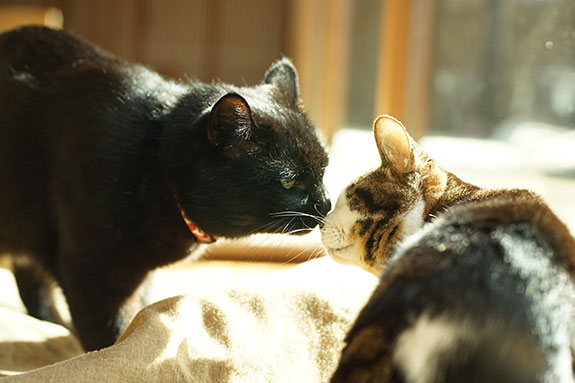How to Introduce Two Cats

As many cat owners know, some cats have personalities that can be tricky to navigate! Depending on a lot of factors, including the environment the cat was raised in, some cats can be very timid, shy, and unsocial, while others can have friendly, social, and more inviting personalities.
One thing that a lot of people assume is that cats are better off in a single-pet household, meaning the cat is the only pet in the house. However, this is not true. In fact, it's recommended that you have another pet in the house if you have a cat because cats are truly social creatures and can develop behavioral problems, depression, and more if left alone too often.
If you already have a cat at home and are considering getting another one, there are a few things you should take into consideration first. In this article, we'll go over what to consider before adding another cat to your home and some steps you can take to make introducing them easy and seamless.
What to Consider
Before getting a new cat, it is always a good idea to consider your cat's personality, energy level, and whether they have gotten along with other cats in the past. This information can help you not only gauge whether or not to get another cat but also to pick a suitable companion and increase their chances of getting along with your resident cat.
The most likely pair to get along is a social female adult and a social male kitten, but only as long as the two cats' personalities aren't aggressive. If they are similar enough, there is a good chance of them getting along. The cat's life stage is also important to take into consideration when introducing two cats. For example, two kittens being introduced are more likely to get along than two adult male cats.
Steps to Take When Introducing Two Cats
Step 1: Keeping Their Distance
The main trick to making sure your cats will likely become friends is taking your time introducing them. This process could take a week, or up to several months depending on the cats, but it is imperative that you do not rush this process. When you bring your new cat home, keep them in a separate room from your other cat. If possible, this room should be one that your resident cat does not spend that much time in.
The cats must then get familiar with the other's scent, and you can achieve this by switching their bedding, and/or petting one cat with a cloth object such as a washcloth or a blanket and giving it to the other cat to smell. In every step of this process, you should be trying to alleviate stress through whatever means; this may be playing, spending adequate quality time with each cat, or even treats or wet food.
Step 2: Getting to See One Another
Once your existing kitty's behavior has returned back to normal, and the new cat is behaving socially and wanting to explore past their room, you may let the cats see each other with a barrier of some sort. You can separate them with an adequately tall and structurally sound baby crate or a small crack in the door that you are positive the cats cannot fit through; just make sure they still have adequate distance between each other (this distance will depend on how comfortable each cat is). This short time should be spent with purely positive reinforcement, teaching the cats that when they are around their "new friend", they get lots of treats and love. If either one of your cats has a favorite toy, only give them this toy in the presence of the other cat from now on. You may also want to let the cats see each other during their normal feeding times.
If a cat reacts negatively, distract them with a toy or treat, and close the barrier again. The duration of these meetings will depend on your cats' comfort level, but it is recommended to start with extremely short meetings, and slowly lengthen them over time.
Step 3: Breaking the Barrier

After slowly closing the distance between the two cats during their meetings with positive reinforcement, it may be time to let the cats meet with no barrier. Do not force the cats to be close to one another or pick them up. Just remove the barrier and let them introduce themselves at their own pace. If any excess aggression is shown aside from a hiss or two, revert to the previous step and try again once you feel that the cats are adequately ready. This process may take up to several months, so patience is key. Although you may feel distraught if you are seeing your cats not get along, please note that it is only necessary to contact your veterinarian if one or both of your cats stop fulfilling their physical needs (eating, using the litter box, etc.) for a prolonged period of time, your cats start spraying, or if there are injuries from fighting.
Conclusion
Two things to keep in mind when introducing cats: it takes time and don't try to rush or force any steps of the process. Always make sure each cat has their own food, water, and litterbox. Doing so will most likely prevent disputes over territory. At the end of the day, you know your cat's personality better than anyone, so be sure to take that into consideration. Just like humans, each cat has its own unique personality and for some, sitting in opposite corners of the room staring at each other is the closest they will get to become friends. That being said, it is entirely possible you can give your kitty and new BFF!
Sources:
Previous article

Next article

Related posts
View all-

Wet Vs. Dry Cat Food: Which is Better?
As a caring cat owner, you always want the best for your furry friend, especially with their food. You typically have two choices: dry cat food in a bag or canned wet food. Whether you've just brought home a new kitty or are looking to transition to a new food, the decision process can be overwhelming, and understanding the impact of each on your cat's diet is essential. Read Article -

Celebrate National Pet Week: Fun Ideas to Celebrate with Your Pet
National Pet Week is right around the corner, so it's time to plan how you're going to celebrate! While we're sure you celebrate your pet all day every day... Read Article -

5 Simple Tips to Make Sure Your Cat Drinks Enough Water
Ensuring your cat stays hydrated is important, but it can be challenging since many cats don't drink enough water. Dehydration can lead to kidney disease and other health issues. Fortunately, you can encourage your cat to drink more with a few simple changes. Read Article



